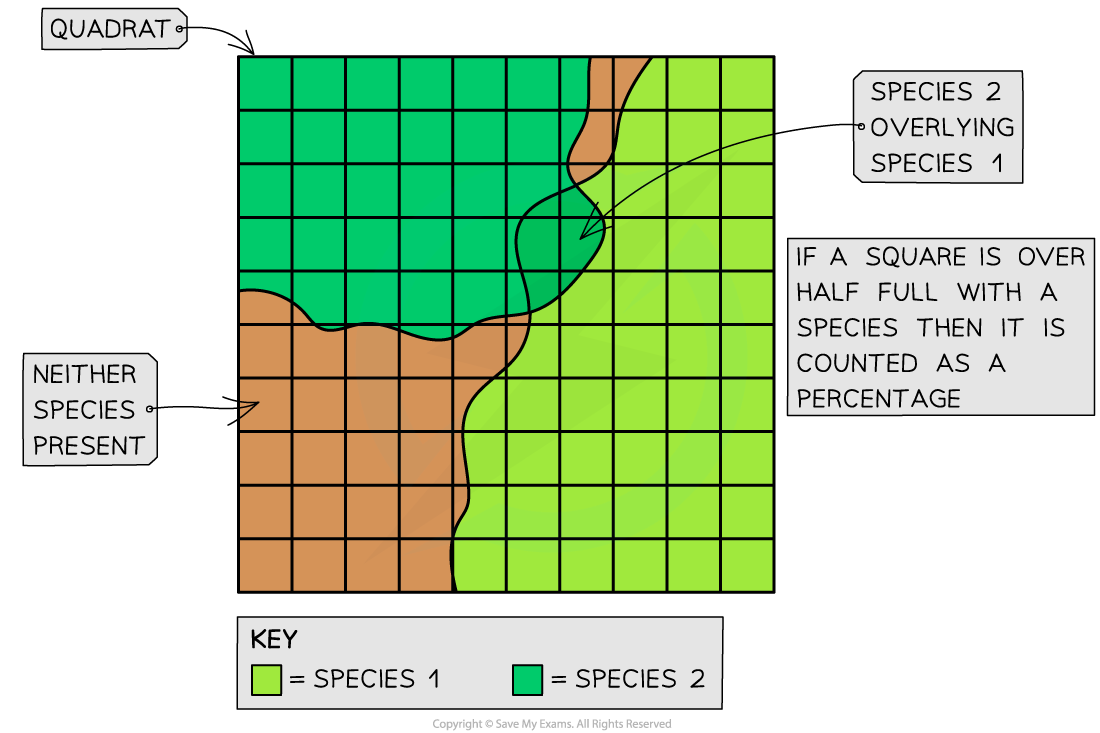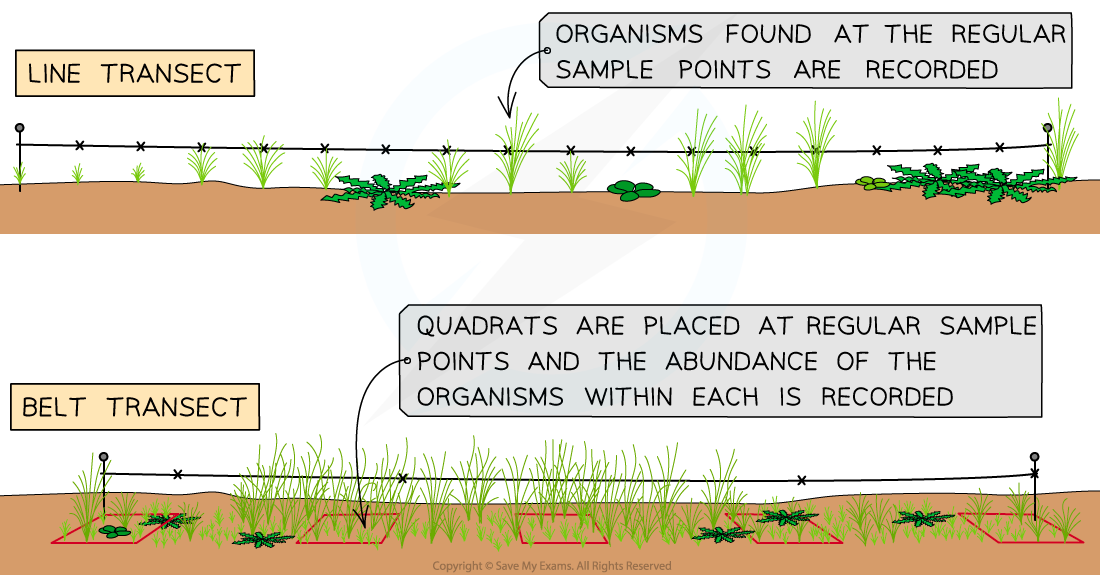Testing for Distribution & Abundance (Cambridge (CIE) A Level Biology) : Revision Note
Testing for Distribution & Abundance
The distribution of a species describes how it is spread throughout the ecosystem
The abundance of a species is the number of individuals of that species
The distribution and abundance of a species in an area can be assessed using different practical methods:
Frame quadrats
Line and belt transects
Mark - release - recapture
Frame quadrats
Some ecosystems are very complex with large numbers of different species of different sizes
For the sake of logistics, sampling is often used to estimate the distribution and abundance of species
When carrying out sampling, square frames called quadrats can be used to mark off the area being sampled
Quadrats of different sizes can be used depending on what is being measured and what is most suitable in the space the samples are being made in
These are usually made of wood or metal and measure 25 cm × 25 cm, 50 cm × 50 cm or 1 m × 1 m
Quadrats must be laid randomly in the area to avoid sampling bias
This random sampling can be done by converting the sampling area into a grid format and labelling each square on the grid with a number
Then a random number generator is used to pick the sample points
Once the quadrat has been laid on the chosen sample point the abundance of all the different species present can be recorded
Results from quadrats
The results from the quadrats can be used to calculate the predicted frequency and density of a species within an area
Species frequency is the probability that the species will be found within any quadrat in the sample area
The number of quadrats that the species was present in is divided by the total number of quadrats and then multiplied by 100
For example, if bluebells were found in 18 out of 50 quadrats the species frequency would be (18÷50) x 100 = 36%
Species density indicates how many individuals of that species there are per unit area
The number of individuals counted across all quadrats is divided by the total area of all the quadrats
For example, if 107 bluebells were found across 50 quadrats that are 1m2 each the species density would be 107/50 = 2.14 individuals per m2
It can sometimes be difficult to count individual plants or organisms. When this is the case percentage cover of the species within the quadrat can be estimated instead
The quadrat is divided into 100 smaller squares
The number of squares the species is found in is equivalent to its percentage cover in that quadrat
For example, if grass is found in 89 out of 100 squares in the quadrat then it has a percentage cover of 89%
Percentage Cover using Quadrats Diagram

Percentage cover of grass in a quadrat - There may be some squares lacking any species and other squares with multiple species overlying one another. Therefore the total percentage cover of a single quadrat can sometimes be over or under 100%
Line & Belt transects
Throughout some areas, there can be changes in the physical conditions
For example, there may be changes in altitude, soil pH or light intensity
When investigating the species distribution in these kinds of areas, systematic sampling is more appropriate
Methods using transects can help show how species distribution changes with the different physical conditions in the area
A transect is a line represented by a measuring tape, along which sample are taken
For a line transect:
Lay out a measuring tape in a straight line across the sample area
At equal distances along the tape record the identity of the organisms that touch the line. For example, every 2m
This produces qualitative data
For a belt transect:
Place quadrats at regular intervals along the tape and record the abundance of each species within each quadrat
This produces quantitative data
Line and Belt Transects Diagram

A line transect and belt transect is carried out in the field
Mark - release - recapture
The methods above are only useful for stationary organisms
Different methods are required for estimating the number of individuals in a population of mobile animals
The mark-release-recapture method is used in conjunction with the Lincoln Index
For a single species in the area:
The first large sample is taken. As many individuals as possible are captured / collected, counted and marked in a way that won’t affect their survival
They are returned to their habitat and allowed to mix randomly with the rest of the population
When a sufficient amount of time has passed another large sample is captured
The numbers of marked and unmarked individuals within the sample are counted
The proportion of marked to unmarked individuals is used to calculate an estimate of the population size
The formula for the calculation is:
Where:
N = population estimate
n1 = number of marked individuals released
n2 = number of individuals in the second sample (marked and unmarked)
m2 = number of marked individuals in the second sample
Worked Example
Lincoln Index with mark-release-recapture
Scientists wanted to investigate the abundance of leafhoppers (Cicadellidae species) in a small grassy meadow. They used sweep nets to catch a large sample of leafhoppers from the meadow.
 |  |
A sweep net used to collect insects Kieren, CC BY 3.0, via Wikimedia Commons | A leafhopper after capture in a sweep net Donald Hobern from Copenhagen, Denmark, CC BY 2.0, via Wikimedia Commons |
Each insect was marked on its underside with non-toxic, waterproof paint and then released back into the meadow. The following day, another large sample was captured from the same area using sweep nets.
No. caught and marked in first sample (n1) = 236
No. caught in second sample (n2) = 244
No. of marked individuals in the second sample (m2) = 71
Using the equation
N (estimated population size) = 811 leafhoppers
Examiner Tips and Tricks
You will be provided with the formula for Lincoln’s index in the exam. You need to be able to carry out the calculation to estimate population size from mark-release-recapture data, as you could be asked to do this in the exam.

You've read 0 of your 5 free revision notes this week
Sign up now. It’s free!
Did this page help you?
